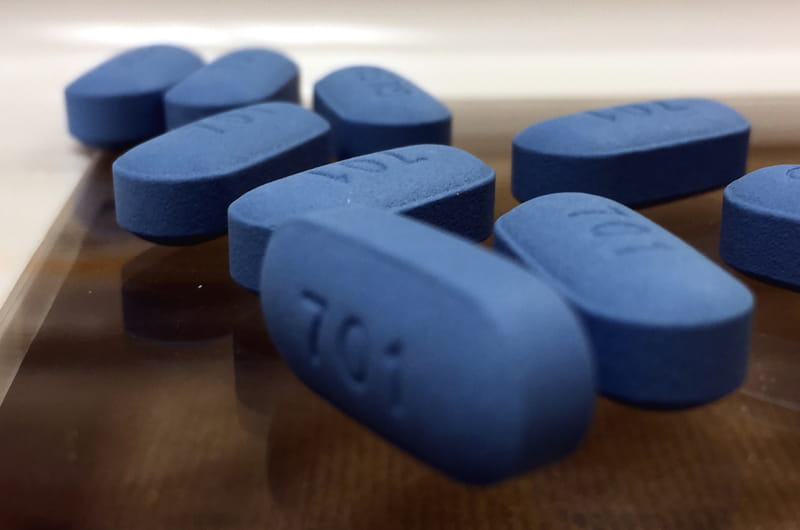The U.S. Could Easily Hit Its 2020 HIV Prevention Goal By Using One Drug, Drexel Study Finds
 By Frank Otto
By Frank Otto

- Drexel Selects New, World-Class Life Sciences Building at 3201 Cuthbert Street for Medical Research Operations
- Breakthrough on Gene Therapy for Hereditary Spastic Paraplegia
- Drexel Environmental Collaboratory Releases Cross-Sector Findings on Severe Weather Recovery Challenges
- Drexel Launches the Manuel Stamatakis Center for Alternative Investments at the LeBow College of Business

If just a quarter of men who have same-sex intercourse and are at a high risk for HIV used daily preventive medicine, three out of every 10 HIV infections could be averted, according to a new Drexel University study.
Michael T. LeVasseur, PhD, and Neal D. Goldstein, PhD, from Drexel’s Dornsife School of Public Health, used a 10,000 person model of high-HIV-risk men who have sex with men (a term used for anyone who engages in same-sex intercourse, regardless of sexual orientation) to determine that prevention level. If it were achieved in the real world, it would more than surpass the United States’ National HIV/AIDS Strategy goal, which is to reduce new infections by 25 percent by 2020.
Their study specifically looked at how the use of a daily preventive drug, collectively called pre-exposure prophylaxis (PrEP) but sold under the brand-name Truvada, would affect HIV transmission rates. And they found that if any segment of the high-risk population used it, there would be an increase in prevention.
“We know that PrEP is highly effective at preventing HIV infection, what we don’t know is how much of an impact it will have at the population level considering the numerous behavioral strategies that men use to prevent infection,” LeVasseur said. “This study attempts to answer this question and future work with this model will attempt to identify specific strategies that will work best to stop the transmission of HIV.”
Published in the Journal of Acquired Immune Deficiency Syndromes, the study by LeVasseur, Goldstein, and their team doesn’t just look at PrEP use alone, but also other prevention methods, both on their own and mixed together. Those other methods included condom use, seroadapive behaviors (such as taking different positions during intercourse to reduce transmission risk) and treatment as prevention (which could reduce the “viral load” and make it less likely to transfer).
The cohort used in the study was compiled with data that would reflect a true-to-life 10,000 person population among urban, non-monogomous men who have sex with men, who were defined by the Center for Disease Control (CDC) as “high-risk.” All of the numbers were derived from the CDC’s study of 21 U.S. cities.
HIV-positive status was assigned to 19 percent of the cohort — 44 percent of whom were unaware — and 36 percent of those in the study that were HIV-negative had not been tested in a year.
The researchers found that when PrEP was the only preventive strategy and used by just 1 percent of the HIV-negative population, it prevented 1.6 percent of infections in the model. And when the study team ratcheted the use up to 25 percent of the cohort, 30.7 percent of the infections that would have otherwise occurred were prevented.
Numbers for the other preventive techniques, used alone, were generated:
- Condom use was found to prevent 48.8 percent of infections;
- Seroadaptive behaviors, 37.7 percent
- Treatment as prevention, 27.1 percent
When all of those efforts were combined, they resulted in the prevention of 72.2 percent of the infections that would have occurred. As such, the independent effect of PrEP was lowered. Still, though, it was found to prevent an additional 5 percent of infections, if 25 percent of the cohort used it.
“PrEP is just another ‘tool in the toolbox’ for HIV prevention, but it is an important one,” LeVasseur said. “PrEP can empower individuals who are in relationships where one person has HIV and the other doesn’t. It can also ease anxieties around HIV testing, as well as enhance sexual intimacy.”
However, PrEP uptake still remains low.
“It’s probably low because of a lack of knowledge among patients, as well as providers, coupled with high costs,” LeVasseur said.
Numbers of how little the uptake there is are difficult to come by, especially since it’s unclear how many men have same-sex intercourse, but “it’s likely true that the minority of eligible men” are taking it.
The company that makes Truvada — the brand-name PrEP — has made efforts to keep costs down, but “PrEP can still be very expensive, although most insurance companies now cover it.”
Results from the model show that the spread of PrEP is invaluable, and LeVasseur believes that not only can PrEP help bring down HIV numbers, it also has an added benefit in encouraging testing for all sexually transmitted infections, as well as a psychological benefit.
“Many men who have sex with men have felt significant anxiety around sexual intimacy due to fear of HIV infection, even with condom use, frequent HIV testing and seroadaptive techniques,” LeVasseur said. “Highlighting how effective these prevention methods are would certainly lead to an increase in PrEP uptake and easing of the mind.”
Loni Philip Tabb, PhD, and Seth Welles, ScD, PhD, both of the Dornsife School of Public Health, and Brianne Olivieri-Mui, of Northeastern University, all co-authored the study, “The Effect of PrEP on HIV Incidence Among Men Who Have Sex with Men in the Context of Condom Use, Treatement as Prevention, and Seroadative Practices,” which can be read here.
In This Article
Contact
Drexel News is produced by
University Marketing and Communications.